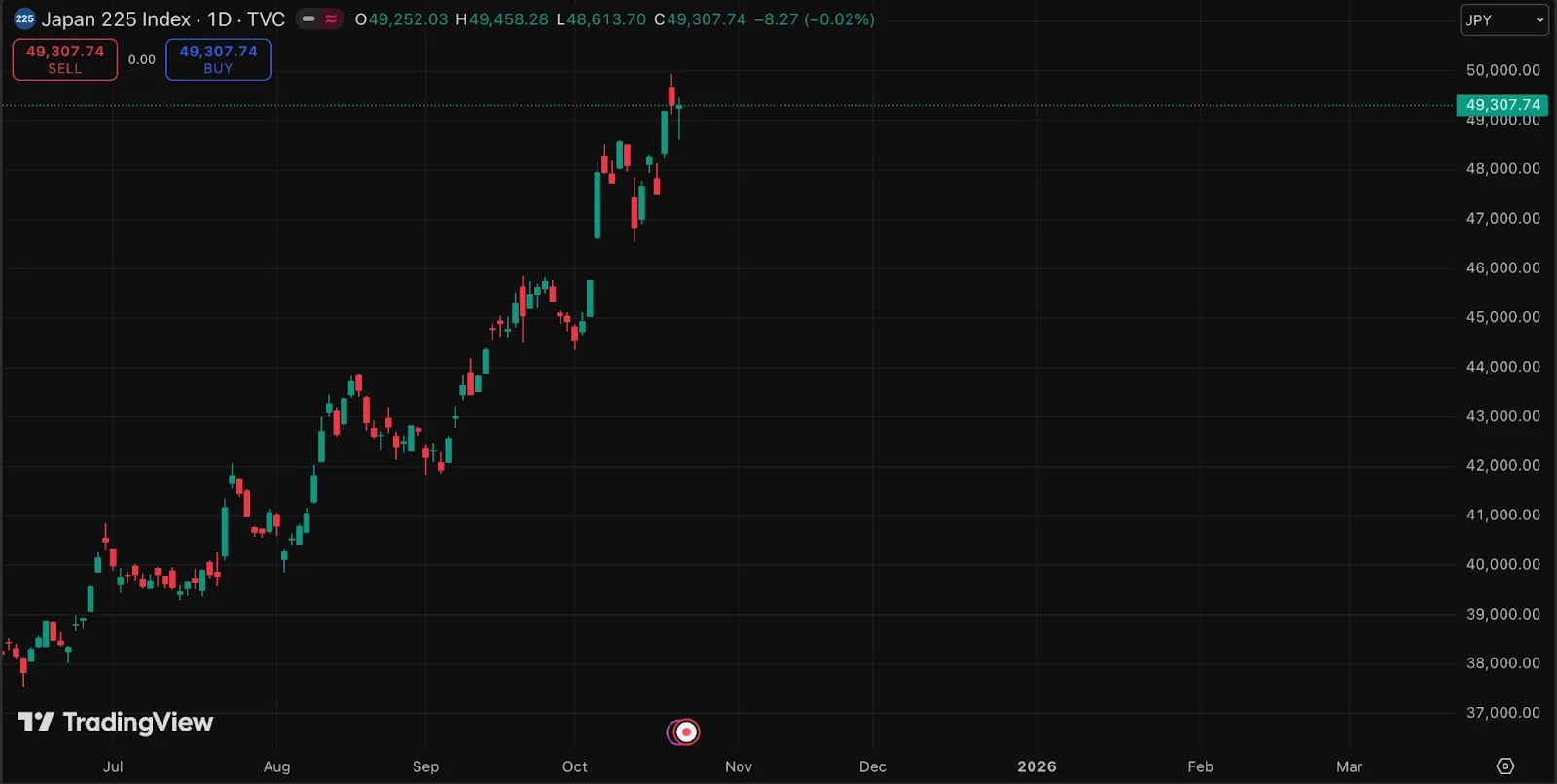توقعات الدولار الأمريكي/الين الياباني: هل يمكن للاقتصاد القوي أن ينجو من الحمائمية المطولة؟

يقول المحللون إن الاقتصاد الياباني يمكن أن يحافظ على زخمه الحالي في ظل سياسة متشائمة مطولة - ولكن ليس إلى أجل غير مسمى. لا يزال النمو ثابتًا، وظل التضخم فوق هدف بنك اليابان البالغ 2٪ لأكثر من ثلاث سنوات، وتتعافى الصادرات أخيرًا.
ومع ذلك، فإن المسار البطيء لبنك اليابان نحو تشديد السياسة وتركيز الحكومة الجديدة على التحفيز المالي يختبران مدى الصبر الذي يمكن للأسواق تحمله. ومع استقرار زوج الدولار الأمريكي/الين الياباني بالقرب من 152، يدرس المتداولون ما إذا كانت أساسيات اليابان القوية يمكن أن تتعايش مع العملة الضعيفة، أو ما إذا كان اختلاف السياسة مع الولايات المتحدة سيدفع الزوج قريبًا نحو 160.
الوجبات السريعة الرئيسية
- انخفض العجز التجاري الياباني بشكل طفيف إلى 234.6 مليار ين في سبتمبر من 242.8 مليار ين في أغسطس، مما يشير إلى زخم الصادرات ولكن دون التوقعات بوجود فائض.
- ارتفعت الصادرات بنسبة 4.2٪ على أساس سنوي، وهي أول زيادة منذ أبريل، بينما ارتفعت الواردات بنسبة 3.3٪، وهي أول زيادة لها في ثلاثة أشهر.
- أظهر استطلاع أجرته رويترز أن 96% من الاقتصاديين يتوقعون أن تصل أسعار بنك اليابان إلى 0.75% بحلول مارس 2026، مع توقع 60% رفع أسعار الفائدة بمقدار 25 نقطة أساس هذا الربع.
- أدى انتخاب ساناي تاكايتشي كأول رئيسة وزراء في اليابان إلى تحفيز مكاسب الأسهم وضعف الين حيث قامت الأسواق بتسعير المزيد من الحوافز المالية وتأخير تشديد بنك اليابان.
- يحوم زوج الدولار الأمريكي/الين الياباني بالقرب من 152، مدعومًا بتوقعات خفض الاحتياطي الفيدرالي لسعر الفائدة وعدم اليقين الواسع بشأن اتجاه السياسة اليابانية.
تفاؤل التحفيز المالي الياباني مقابل القيود المالية
يمثل انتخاب ساناي تاكايتشي علامة تاريخية - أول رئيسة وزراء يابانية - ونقطة تحول واضحة في السياسة. تركز منصة Takaichi على التنشيط الاقتصادي والاستثمار الدفاعي والعلاقات الأمريكية القوية، مما يشير إلى استعداد الحكومة للإنفاق.
ووعد ائتلافها، الذي تم تشكيله مع حزب الابتكار الياباني، بالتحفيز المالي لدفع النمو - مرددًا عناصر اقتصاد آبي.
ارتفع مؤشر Japan 225 بنسبة 13٪ تقريبًا منذ أوائل أكتوبر، واقترب لفترة وجيزة من مستوى 50,000 قبل بدء جني الأرباح.

ومع ذلك، فإن التفاؤل بشأن النمو القائم على التحفيز قد ضغط في نفس الوقت على الين، حيث يتوقع المتداولون تأخيرًا في تطبيع بنك اليابان. ومع ذلك، تواجه إدارة تاكايتشي قيودًا.
أما مقاعد الائتلاف البالغ عددها 231 مقعدًا في مجلس النواب فهي أقل من 233 مقعدًا المطلوبة للحصول على الأغلبية، مما أجبرها على الاعتماد على دعم المعارضة لتمرير التشريعات. يحد هذا الموقف البرلماني الضعيف من حجم التوسع المالي ويضخ عدم اليقين السياسي في التوقعات الاقتصادية لليابان.
أسعار الفائدة لبنك اليابان: المرونة تتحدى الجمود السياسي
أصبحت الصورة الكلية لليابان قوية بشكل غير متوقع.
- وانخفض العجز التجاري للشهر الثاني، مدفوعاً بتحسن أداء الصادرات واعتدال تكاليف الاستيراد.
- ارتفعت الصادرات بنسبة 4.2% على أساس سنوي، مسجلة أول زيادة لها منذ أبريل، بدعم من الطلب من آسيا وأوروبا.
- وقفزت الواردات بنسبة 3.3%، وهي أقوى مكسب لها في ثمانية أشهر، مما يعكس الاستهلاك المحلي القوي وارتفاع تكاليف الطاقة.
وفي الوقت نفسه، توسع الناتج المحلي الإجمالي لليابان لمدة خمسة أرباع متتالية، مما يؤكد التعافي الدائم من ركود عام 2023.

التضخم لا تزال أعلى من 2%، مدعومة بارتفاع الأجور والطلب في قطاع الخدمات. ستؤدي هذه الظروف إلى تشديد السياسة في أي اقتصاد رئيسي آخر.

ومع ذلك، وعلى الرغم من هذه الأساسيات، يظل بنك اليابان البنك المركزي الرئيسي الوحيد الذي لا يزال أقل من معدلات الفائدة البالغة 1%. أكد نائب المحافظ شينيتشي أوتشيدا أن الزيادات المستقبلية ستعتمد على «اتجاهات التضخم المستدامة»، بينما صرح عضو مجلس الإدارة هاجيمي تاكاتا أن اليابان «حققت تقريبًا» هدفها السعري - مما يشير إلى التفاؤل الحذر ولكن ليس الإلحاح.
يؤدي عدم التوافق بين البيانات الاقتصادية القوية والسياسة المترددة إلى إبقاء الين تحت الضغط، حيث يبحث المستثمرون في أماكن أخرى عن العائد.
سعر سياسة بنك اليابان: الطريق البطيء إلى 0.75%
يتوقع السوق التغيير - ولكن ليس بسرعة. وفقًا لمسح أجرته رويترز، توقع 64 من 67 اقتصاديًا (96٪) أن تصل سياسة بنك اليابان إلى 0.75٪ بحلول مارس 2026، حيث يتوقع 45 من 75 مستجيبًا (60٪) رفع سعر الفائدة بمقدار 25 نقطة أساس هذا الربع.
ويؤكد هذا الجدول الزمني مدى التدرج الذي سيكون عليه التطبيع مع بنك اليابان. تعتمد استراتيجية بنك اليابان على ضمان استمرار مكاسب الأجور وليس مجرد نتيجة للتضخم الناتج عن زيادة التكاليف. لكن الخطر يكمن في أن الصبر يتحول إلى جمود سياسي، مما يجعل الين عرضة لتدفق رأس المال إلى الخارج إذا خففت البنوك المركزية الأخرى بشكل أسرع.
عبر المحيط الهادئ: تخفيضات الاحتياطي الفيدرالي والفوضى المالية والتعب من الدولار
يتداول مؤشر الدولار الأمريكي (DXY) بالقرب من 98.96، منخفضاً بعد انتعاش قصير. أدى إغلاق الحكومة الأمريكية الذي يلوح في الأفق، والذي دخل الآن أسبوعه الرابع، إلى تجميد إصدارات البيانات الرئيسية وغيوم رؤية الاحتياطي الفيدرالي. فشل مجلس الشيوخ 11 مرة في تمرير مشروع قانون التمويل، مما يجعله ثالث أطول إغلاق في تاريخ الولايات المتحدة.
تبلغ أسعار أداة CME FedWatch الآن فرصة 96.7٪ لخفض سعر الفائدة في أكتوبر وفرصة 96.5٪ لخفض سعر الفائدة مرة أخرى في ديسمبر.

يميل مسؤولو الاحتياطي الفيدرالي إلى الحمائمية:
- يدعم كريستوفر والر خفضًا فوريًا آخر،
- يدافع ستيفن ميران عن مسار تيسير أكثر جرأة في عام 2025، و
- أكد جيروم باول أن الاحتياطي الفيدرالي «يسير على الطريق الصحيح» لخفض آخر بمقدار ربع نقطة.
مع تباطؤ الاقتصاد الأمريكي، يتقلص فرق السعر بين اليابان والولايات المتحدة، مما يجعل الدولار أقل هيمنة. أسرع الاحتياطي الفيدرالي وبالتالي يمكن للمحور أن يضع حدًا صعوديًا للدولار الأمريكي مقابل الين الياباني، حتى بدون تدخل بنك اليابان.
الرؤية الفنية للدولار الأمريكي مقابل الين الياباني: بين الأمل المالي والعوائق السياسية
وقد أدى تعيين وزير المالية ساتسوكي كاتاياما - المعروف بتفضيله لزيادة قوة الين ووصف 120-130 دولارًا أمريكيًا بأنه «مبرر بشكل أساسي» - إلى إدخال نبرة أكثر توازنًا. ومع ذلك، لا يزال وضع السوق الأوسع يميل نحو ضعف الين.
يشير المحللون في Commerzbank إلى أنه من غير المرجح أن يدعم التوجه الحكومي الجديد الصديق للأعمال انخفاض قيمة العملة على المدى الطويل، ويتوقعون حركة جانبية للدولار الأمريكي مقابل الين الياباني حيث أن الضغط المالي الياباني وصبر بنك اليابان يعوضان بعضهما البعض.
بعد ثلاث جلسات متتالية من الخسائر، ارتفع الين بشكل طفيف في منتصف الأسبوع بعد صدور البيانات التجارية. تراجع زوج الدولار الأمريكي/الين الياباني بشكل متواضع ولكنه لا يزال بالقرب من 151.84. من المرجح أن تواجه الحركة الصاعدة مقاومة عند مستوى سعر 153.05، مع مؤشر القوة النسبية مما يظهر قوة زخم الشراء. على العكس من ذلك، إذا ساد البائعون، فمن المرجح أن يجدوا الدعم عند مستويات الأسعار 150.25 و 146.70.

يمكن للمتداولين تتبع هذه المستويات في الوقت الفعلي باستخدام مشتق MT5 وقد تفكر في وضعها وقف الخسارة أوامر بالقرب من منطقة الدعم 150.25 لإدارة المخاطر في هذا الزوج المتقلب. يساعد استخدام التقويم الاقتصادي لـ Deriv على توقع إعلانات بنك اليابان أو الاحتياطي الفيدرالي التي عادة ما تحرك الين.
تأثير السوق والآثار التجارية
بالنسبة للمتداولين، يقدم الدولار الأمريكي/الين الياباني توازنًا نادرًا بين المخاطر والمكافأة.
- حافظة على الجانب العلوي: إذا قام بنك اليابان بتأجيل تشديد السياسة النقدية بينما ظل الاحتياطي الفيدرالي حذرًا، فقد يعيد زوج الدولار الأمريكي/الين الياباني اختبار 158-160، مما يختبر قدرة السوق على تحمل ضعف الين.
- حالة الجانب السلبي: وفي حالة خفض الاحتياطي الفيدرالي لمرتين وقام بنك اليابان برفع سعر الفائدة ولو بشكل متواضع، فقد يتراجع الزوج إلى 145-147، ليتراجع بذلك عن جزء من ارتفاع عام 2024.
ال التجارة المحمولة لا يزال المحرك الرئيسي لمعنويات الين. مع استمرار المستثمرين العالميين في الاقتراض بالين لتمويل المراكز ذات العائد المرتفع بعملات أخرى، فإن أسعار الفائدة المنخفضة في اليابان تحافظ على دور الين الياباني كعملة تمويل عالمية. قد يؤدي أي تحول في سياسة بنك اليابان أو زيادة مفاجئة في تقلبات السوق إلى تراجع التجارة المحمولة، مما يؤدي إلى ارتفاع سريع في الين.
لا تزال النغمة على المدى القريب محدودة النطاق، لكن مخاطر التقلب مرتفعة حيث تتجه السياسة والسياسة في اتجاهين متعاكسين. قد يجد متداولو الأسهم الدعم في أجندة التحفيز اليابانية، بينما يجب على تجار العملات الاستعداد لإعادة ضبط بنك اليابان المحتملة قبل منتصف عام 2026.
في نهاية المطاف، أثبت الاقتصاد الياباني القوي مرونته - لكن عملتها قد لا تبقى صبورة إلى الأبد. لم يعد السؤال لعام 2025 هو ما إذا كانت اليابان قادرة على النمو، ولكن إلى أي مدى يمكن أن تتحمله قوتها قبل أن تفرض الأسواق يد بنك اليابان.
أرقام الأداء المذكورة ليست ضمانًا للأداء المستقبلي.



